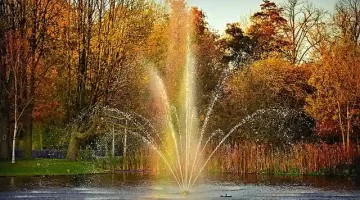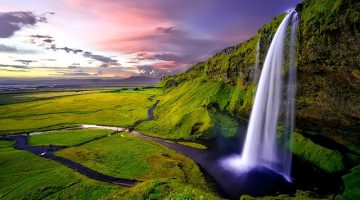Best Time to Visit Iceland
The Travel Pages picks the best time to visit Iceland, with a monthly summary of the weather, plus hotel prices and special events to help plan a visit.
Iceland, the land of fire and ice. Known for its breathtaking landscapes, geothermal springs, and captivating Northern Lights, it’s a destination that’s on many a traveler’s bucket list. But when is the best time to visit Iceland? Well, that depends on what you’re looking for. With a climate that’s as varied as its landscapes, there’s no one-size-fits-all answer. So, let’s take a month-by-month look at what Iceland has to offer.

Best Time to Visit Iceland: Month by Month
Starting with January, the heart of winter in Iceland. Expect average temperatures to hover around 32°F (0°C), with potential dips below freezing. Average rainfall is about 3 inches (76.2mm), and snow is quite common. Hotel prices are at their lowest, and if you’re lucky, you might catch the Northern Lights. Just remember to pack warm!
February is similar to January in terms of weather. Temperatures average around 33°F (0.5°C), and snowfall is still common. Rainfall is slightly less, at around 2.8 inches (71.12mm). The Winter Lights Festival in Reykjavik is a highlight, illuminating the city with dazzling light installations.
March sees a slight increase in temperature, with averages around 35°F (1.6°C). Rainfall is about 2.5 inches (63.5mm), and snow is less frequent. Hotel prices remain low, and the DesignMarch festival in Reykjavik showcases the best of Icelandic design. Note that despite its name, the festival has taken place as late as May and in 2024 is scheduled for April!

April brings spring to Iceland, with temperatures averaging 39°F (3.9°C). Rainfall is about 2 inches (50.8mm), and snow is rare. Hotel prices start to increase, and the First Day of Summer, a national holiday, is celebrated with parades and entertainment.
May sees temperatures rise to an average of 45°F (7.2°C), and rainfall decreases to 1.8 inches (45.72mm). Hotel prices continue to rise, and the Reykjavik Arts Festival is a must-see for art lovers.
June brings summer to Iceland, with average temperatures of 50°F (10°C) and rainfall of 1.6 inches (40.64mm). Hotel prices are at their peak, and the Midnight Sun phenomenon, where the sun barely sets, is a unique experience.
July is the warmest month in Iceland, with temperatures averaging 54°F (12.2°C) and rainfall at 1.5 inches (38.1mm). Hotel prices remain high, and the Verslunarmannahelgi, a national holiday with music festivals and events, is a highlight.
August sees temperatures around 52°F (11.1°C) and rainfall of 2 inches (50.8mm). Hotel prices start to decrease, and the Reykjavik Culture Night, a city-wide celebration of arts and culture, is a major event.
September brings the start of autumn, with temperatures averaging 48°F (8.9°C) and rainfall increasing to 2.5 inches (63.5mm). Hotel prices continue to decrease, and the Reykjavik International Film Festival is a must for film enthusiasts.
October sees temperatures drop to 43°F (6.1°C), and rainfall increases to 3.1 inches (78.74mm). Hotel prices are lower, and the Imagine Peace Tower, a memorial to John Lennon from Yoko Ono, is lit.
November brings the real onset of winter, with temperatures averaging 36°F (2.2°C) and rainfall of 3.3 inches (83.82mm). Hotel prices are at their lowest, and the Iceland Airwaves music festival is a highlight.
December is a cold but festive month in Iceland, with temperatures around 34°F (1.1°C) and rainfall of 3.4 inches (86.36mm). Snow is common, and hotel prices are low. The Christmas and New Year celebrations are magical, with fireworks lighting up the sky.

Best Time to Visit Iceland: Summarised
So, what’s the best time to visit Iceland? Well, it depends on what you’re after. If you’re a fan of winter landscapes and the Northern Lights, the colder months could be for you. But if you prefer milder weather and longer days, the summer months might be more up your alley.
Remember, the Iceland climate is unpredictable, so be prepared for sudden changes in weather, regardless of when you visit. And while the Iceland weather might be a major factor in deciding when to go, don’t forget to consider the events and festivals that could enhance your visit.

If you’re looking to save on accommodation, the winter months offer the lowest hotel prices. But keep in mind that some roads and attractions may be closed due to weather conditions.
On the other hand, the summer months, while more expensive, offer longer days and more favorable weather for outdoor activities. Plus, you’ll get to experience the Midnight Sun, a phenomenon that’s truly unique to this part of the world.
Ultimately, the best time to visit Iceland is when it suits you best. Whether you’re a nature lover, a culture vulture, or a budget traveler, there’s something for everyone in Iceland, no matter the season.
So, pack your bags, book your tickets, and get ready to explore the land of fire and ice! It really is one of the most remarkable countries we’ve ever seen anywhere on our travels.











